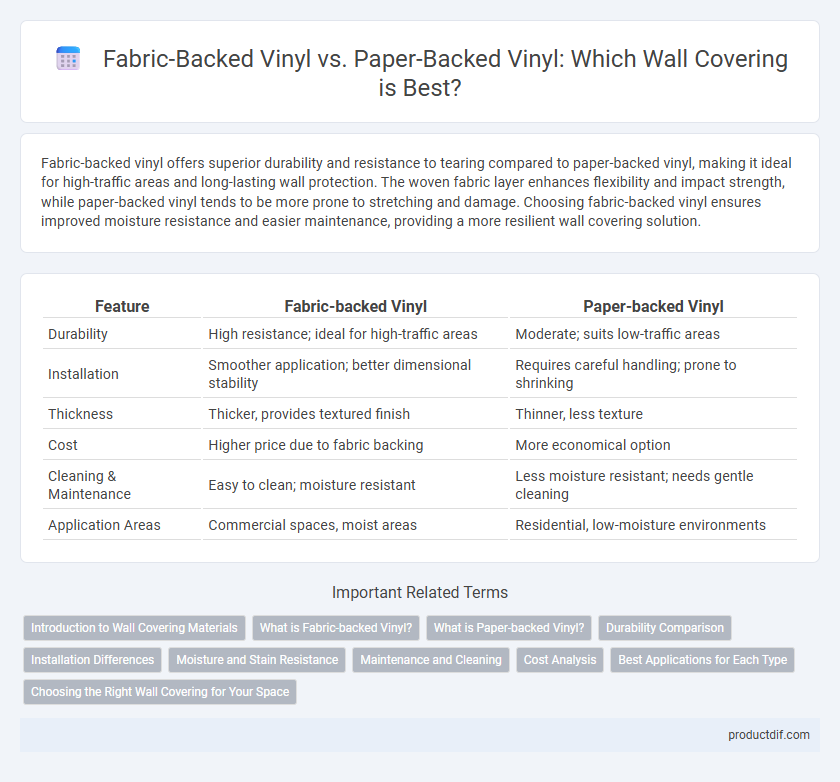Fabric-backed vinyl offers superior durability and resistance to tearing compared to paper-backed vinyl, making it ideal for high-traffic areas and long-lasting wall protection. The woven fabric layer enhances flexibility and impact strength, while paper-backed vinyl tends to be more prone to stretching and damage. Choosing fabric-backed vinyl ensures improved moisture resistance and easier maintenance, providing a more resilient wall covering solution.
Table of Comparison
| Feature | Fabric-backed Vinyl | Paper-backed Vinyl |
|---|---|---|
| Durability | High resistance; ideal for high-traffic areas | Moderate; suits low-traffic areas |
| Installation | Smoother application; better dimensional stability | Requires careful handling; prone to shrinking |
| Thickness | Thicker, provides textured finish | Thinner, less texture |
| Cost | Higher price due to fabric backing | More economical option |
| Cleaning & Maintenance | Easy to clean; moisture resistant | Less moisture resistant; needs gentle cleaning |
| Application Areas | Commercial spaces, moist areas | Residential, low-moisture environments |
Introduction to Wall Covering Materials
Fabric-backed vinyl wall coverings offer enhanced durability, moisture resistance, and a textured appearance, making them ideal for high-traffic areas or spaces prone to wear. Paper-backed vinyl, while more affordable and easier to install, provides less durability and moisture resistance, suited for low-traffic or residential environments. Choosing between these materials depends on factors such as room usage, budget, and desired aesthetic qualities in wall covering applications.
What is Fabric-backed Vinyl?
Fabric-backed vinyl is a durable wall covering composed of a vinyl surface laminated onto a woven fabric backing, commonly polyester or fiberglass, enhancing strength and flexibility. This construction provides superior tear resistance, making it ideal for high-traffic areas and commercial environments where longevity is essential. Fabric-backed vinyl also offers improved dimensional stability and better wrinkle resistance compared to paper-backed vinyl, ensuring a smooth, professional finish on walls.
What is Paper-backed Vinyl?
Paper-backed vinyl is a type of wall covering featuring a vinyl surface adhered to a paper backing, combining durability with ease of application. This backing provides a lightweight and breathable substrate, making it suitable for smooth installation on interior walls while maintaining resistance to moisture and stains. Often preferred for residential and commercial spaces, paper-backed vinyl balances cost-effectiveness with moderate durability compared to fabric-backed vinyl options.
Durability Comparison
Fabric-backed vinyl wall coverings offer superior durability compared to paper-backed vinyl due to their reinforced layer of woven fabric, making them resistant to tearing, abrasion, and moisture. Paper-backed vinyl is more prone to damage from scrapes and humidity, reducing its lifespan in high-traffic or damp environments. The enhanced strength and moisture resistance of fabric-backed vinyl make it the preferred choice for commercial and high-use residential spaces.
Installation Differences
Fabric-backed vinyl offers greater durability and flexibility during installation, allowing it to conform smoothly over uneven surfaces and resist tearing, which makes it ideal for high-traffic areas. Paper-backed vinyl is lighter and easier to handle but tends to be less forgiving on textured walls and more prone to bubble formation or tearing during application. Precision in wall preparation is crucial for paper-backed vinyl, while fabric-backed vinyl provides a more forgiving installation process with superior adhesive grip and long-term resilience.
Moisture and Stain Resistance
Fabric-backed vinyl offers superior moisture and stain resistance compared to paper-backed vinyl, making it ideal for high-humidity environments such as bathrooms and kitchens. Its durable construction prevents water absorption and inhibits mold growth, enhancing longevity and maintaining aesthetic appeal. Paper-backed vinyl, while more cost-effective, lacks the same protective qualities and is prone to warping and staining when exposed to moisture.
Maintenance and Cleaning
Fabric-backed vinyl offers superior durability and resistance to moisture, making it easier to clean and maintain in high-traffic areas compared to paper-backed vinyl. Paper-backed vinyl tends to be more susceptible to peeling and damage from water exposure, requiring gentler cleaning methods to avoid deterioration. Choosing fabric-backed vinyl enhances longevity and simplifies upkeep, especially in environments prone to spills or frequent cleaning.
Cost Analysis
Fabric-backed vinyl wall coverings generally cost more upfront than paper-backed vinyl due to their enhanced durability and higher-quality materials. Installation expenses for fabric-backed vinyl are often higher because of its heavier weight and need for specialized adhesives. While paper-backed vinyl is more budget-friendly initially, its shorter lifespan may lead to increased long-term replacement and maintenance costs.
Best Applications for Each Type
Fabric-backed vinyl excels in high-traffic commercial spaces due to its enhanced durability and tear resistance, making it ideal for restaurants, healthcare facilities, and schools. Paper-backed vinyl suits residential and low-traffic environments where budget-friendly aesthetics and ease of installation are priorities, such as bedrooms and living rooms. Choosing between fabric-backed and paper-backed vinyl depends on the required longevity, exposure to wear, and maintenance needs in the specific application.
Choosing the Right Wall Covering for Your Space
Fabric-backed vinyl offers superior durability and moisture resistance, making it ideal for high-traffic or humid environments such as kitchens and bathrooms. Paper-backed vinyl, while more affordable and easier to install, suits low-traffic areas and spaces with minimal moisture exposure due to its lower resistance to wear and tear. Selecting the right wall covering depends on factors like room usage, environmental conditions, and maintenance requirements to ensure longevity and aesthetic appeal.
Fabric-backed Vinyl vs Paper-backed Vinyl Infographic

 productdif.com
productdif.com